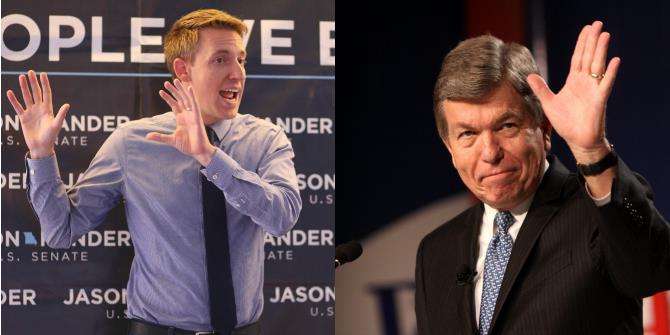 With 52 members, California controls the largest representation of any US state in the US House of Representatives. Renée Van Vechten gives an overview of the state’s Congressional politics, writing that the California’s political reforms, such as the use of nonpartisan redistricting, mean that only a handful of races can be considered “toss-ups” going into the 2024 elections. With control of Congress potentially hinging on the outcome of only a few seats, however, California’s November results could make all the difference.
With 52 members, California controls the largest representation of any US state in the US House of Representatives. Renée Van Vechten gives an overview of the state’s Congressional politics, writing that the California’s political reforms, such as the use of nonpartisan redistricting, mean that only a handful of races can be considered “toss-ups” going into the 2024 elections. With control of Congress potentially hinging on the outcome of only a few seats, however, California’s November results could make all the difference.
- This article is part of ‘The 2024 Elections’ series curated by Peter Finn (Kingston University). Ahead of the 2024 election, this series is exploring US elections at the state and national level. If you are interested in contributing to the series, contact Peter Finn (p.finn@kingston.ac.uk).
California has 52 seats in the US House of Representatives, making up nearly one in eight House members, with incumbents facing reelection every two years. Incumbents are rarely defeated, and as the ideological divide between the major political parties has become entrenched, only a few seats are likely to change party hands with the 2024 election. This year, Californians have a slender chance of influencing a political party changeover in a closely divided chamber where 218 votes are needed to pass a bill and Republicans hold exactly that number. Because every member counts and both parties consider a majority to be within reach, both are hyper-focused on a handful of seats that they view as winnable. Only a few Congressional districts in California remain in the “toss-up” category, a number that has been minimized by the state’s penchant for political reforms, with nonpartisan redistricting leading the list.
California’s Citizens Redistricting Commission
Unlike 31 other US states in which state legislatures draw Congressional and their own district boundaries, California conducts its redistricting process through a curated group of citizens who are screened, selected, and convened every ten years after a census takes place. Voters established the Citizens Redistricting Commission (CRC) in 2008 with a constitutional initiative, as have most of the other nine states with strictly citizen-driven redistricting processes. Elected officials, it turns out, don’t enjoy surrendering the power to draw their own districts; they have not only tried but failed to invalidate non-legislative redistricting systems through court challenges, but also have found ways to participate in several of the other “independent” commissions.
Not in California, where redistricting commissioners are charged with a nonpartisan mission: to identify communities of interest and ignore the fate of incumbents and parties as they determine how to dissect the state map into jagged geographic pieces that encompass equal numbers of people. Having recreated the maps twice in history, the CRC does not “gerrymander,” or manipulate boundaries to benefit or disadvantage groups, persons, or parties. Each “single-member district” is represented by one elected person, and social science research shows that Democrats could pick up at least four additional seats in California in addition to the forty they currently hold if politicians were still in charge of the process – a phenomenon that has advantaged House Republicans nationally.
California’s 2024 “toss-up” election races
California Democrats haven’t given up on gaining more seats, even if the maps already favor them due to a two-to-one advantage over Republicans in voter registration, and “No Party Preference” registrants who side more often with Democrats. Seeking to reinforce the state’s delegation by flipping several seats now occupied by Republicans, state Democrats’ clearest chances lie with three races that are widely considered “toss-ups,” mainly because the voter bases have trended slightly Democratic in the last two presidential contests and the winners’ margins of victory were narrow in 2022. Beyond these, a few—perhaps as few as five or as many as seven others, according to seasoned election observers—are rated as moderately vulnerable to a party switch.
In the case of District 13 in the agriculture-rich San Joaquin Valley, newcomer Republican John Duarte bested his challenger, Democrat Adam Gray, by merely 564 votes out of more than 133,000 cast in 2022. Both won the top spots in the March primary and are locked in a rematch. An uncannily similar reprise is taking place in District 22, also a well-farmed area of the San Joaquin Valley, between Republican Congressman David Valadao (first elected in 2012) and Democratic opponent Rudy Salas. Valadao won the 2022 contest by roughly 3,100 votes.

“Welcome to California, Nevada-California” (CC BY-SA 2.0) by Ken Lund
Further south, District 27 in northwest Los Angeles County features Republican incumbent and Navy veteran Mike Garcia versus Democrat George Whitesides, former CEO of space vehicle manufacturer Virgin Galactic. Garcia won with 53.2 percent of the vote in 2022, a victory small enough for him to be considered vulnerable in an area that leans slightly Democratic. Republican Ken Calvert, who has served in Congress for thirty years, also won by a whisker with 52.3 percent, but his district tilts conservative. Republicans, on the other hand, have seized the chance to flip an open Orange County Democratic-leaning seat with the candidacy of former state legislator Scott Baugh, who barely lost the last contest with 48.3 percent of the vote, and they will try to recapture two other “likely Democratic” seats.
What is motivating voters in the Golden State?
Election replays at the federal level capture the sharp divisiveness and close competitiveness of the major political parties, and California voters translate national forces into presidential and down-ballot races, just as other voters in other states do. According to June 2024 polls, three out of four Californians say they plan to vote (although turnout rates normally fall well below voter-reported thresholds, despite the fact that a ballot will be mailed to each voter in California), and among those who are not inclined to vote, the most common reason given for not voting is not liking either presidential candidate.
The moral undertow of Supreme Court decisions about reproductive rights is likely to motivate voters’ decision making this year, and the presidential campaigns will try to activate others by over- or underplaying “threats” posed by immigrants and the other candidate, among other appeals. Statewide polls confirm that wresting the cost of living under control is also on California voters’ minds. For instance, the median price of a home continues to escalate well beyond the reach of most residents—a staggering $900,000 in spring 2024—and they are looking for relief; yet they tend to stick with the party they trust, harmonizing with fellow partisans’ messaging. This is to say that despite the push and pull of day-to-day issues on voters, the overwhelming majority will vote for the person who represents their preferred party, and few will cross party lines unless forced to do so.
What the Top-Two primary system means for 2024 in California
California’s electoral reforms also make that possible, compelling general election voters to choose between the two candidates who received the most votes in the primary election. The presidential contest and local offices excepted, the competitors for federal and state offices are winnowed through a system that is commonly referred to as a “jungle primary.” Modeled after a process first used in the state of Washington, California’s Top-Two primary system jettisons the prevailing partisan primary for a voter-preference primary, enabling all candidates for an office to be listed on the ballot, and all voters to cast their vote for the person they desire, without respect to party affiliation. The two candidates receiving the most votes then advance to the general election, creating opportunities for intraparty matchups, or situations where two Democrats vie for the same office, or two Republicans. Only five states including California use some version of a voter-preference or “all-comers” primary.
Although the intention behind the Top-Two schema was to boost the election of moderates in districts where one party is strongly favored (i.e., where ideologically extreme candidates are also advantaged through districting), political science research demonstrates mixed effects overall. This year, three final Congressional races are Democrat-only contests, and one is Republican-only. None of those seats will change party hands, although three are being vacated by long-serving members (Democrats Barbara Lee and Anna Eshoo who have served a combined sixty years in Congress, and former Republican Speaker of the House, Kevin McCarthy) whose retirements will likely reduce the overall power that Californians wield and the heft they lend to policy debates in the House.
Barring an unlikely last-minute election surprise that breaks the current stalemate between the national parties, within the national context the 2024 California election outcomes are unlikely to shift more than a couple of seats, if any. But in an environment where every vote counts, that might be enough to matter enormously.
- Please read our comments policy before commenting.
- Note: This article gives the views of the author, and not the position of USAPP – American Politics and Policy, nor the London School of Economics.
- Shortened URL for this post: https://wp.me/p3I2YF-e1R






